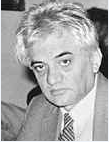Short Commentary
Chromogranins and Secretogranins as Prohormones: Consequences for Endocrinology as A Science of Bioregulation
Member of ISOAD, PhD in Biochemistry, Santa Maria – RS, Brazil.
*Corresponding Author: Viktor I. Goudochnikov, Member of ISOAD, PhD in Biochemistry, Santa Maria – RS, Brazil.
Citation: Goudochnikov V I. (2025). Chromogranins and Secretogranins as Prohormones: Consequences for Endocrinology as A Science of Bioregulation. Journal of Endocrinology and Diabetes Research, BioRes Scientia Publishers. 3(1):1-2. DOI: 10.59657/2996-3095.brs.25.021
Copyright: © 2025 Viktor I. Goudochnikov, this is an open-access article distributed under the terms of the Creative Commons Attribution License, which permits unrestricted use, distribution, and reproduction in any medium, provided the original author and source are credited.
Received: February 08, 2025 | Accepted: February 28, 2025 | Published: March 20, 2025
Abstract
In a short commentary two related topics are discussed: about chromogranins and secretogranins as prohormones and on endocrinology as a science of bioregulation.
Keywords: chromogranins; secretogranins; endocrinology; bioregulation
Introduction
For a long time chromogranins and secretogranins were considered to be merely the proteins necessary for package of hormonal compounds in secretory granules (or vesicles). It appears that Karen B. Helle from University of Bergen, Norway, was one of the first to isolate these proteins and to suggest that they may serve as prohormones [1]. At present it is already well known that at least some of them, like chromogranin A can produce a series of biologically active peptides, among which one can mention catestatin, parastatin, pancreastatin and many others. This production is realized by means of physiological proteolysis using enzymes called proconvertases, in a manner similar to production of corticotropin and other peptides from opiomelanocortin in pituitary corticotrophs [2, 3]. Unfortunately, although we have participated formally in one of symposia organized by K.B. Helle [4], our attention at that time was entirely focused on the known pituitary hormonal proteins, in particular growth hormone (GH) and prolactin. However, just recently we have launched an hypothesis trying to explain the long-known fact of the presence in anterior pituitary of some sort of metabolic inhibitor [5], unidentified till the present moment, via the existence of at least one of chromogranins or secretogranins and peptide products of their proteolysis [6].
On the other hand, already at the end of fifties of the last century the physiologist from Buenos Aires, Argentina, Bernardo Alberto Houssay, Nobel prize laureate has shown the presence in pituitary gland of a diabetogenic substance [7], also not identified till the present time. But perhaps, at least pancreastatin that inhibits insulin secretion may be a candidate for such biological activity contributing to pathogeny of metabolic syndrome [8]. It is interesting that already in 1979 we have shown an increased secretion of GH and prolactin in primary cultures of anterior pituitary cells isolated from rats with acute alloxan-induced experimental diabetes [9]. Later on we have observed inhibitory action of insulin on GH secretion by cultured anterior pituitary cells from adult rats, as well as by pup cells after their premedication in vitro with glucocorticoid and thyroid hormone [10]. Nevertheless, at the end of eighties of the last century we have developed a method of preparative electrophoresis in polyacrylamide gel in mildly acidic conditions that has shown the existence of unidentified pituitary proteins, besides GH and prolactin [11]. Therefore, in our recent article [6] we tried to use this fact for launching our hypothesis mentioned above for explanation of metabolic inhibitor in anterior pituitary.
However, chromogranins and secretogranins are present not only in pituitary gland, but also in other endocrine organs and moreover, in the cells of so called diffuse neuroendocrine system (DNES) [12] that together with cells of “classical” endocrine organs appear to differentiate from neuroectoderm precursors in early development. That’s why we need to alter our recent hypothesis [6] by adding a proposal of tissue-specific expression of chromogranins and secretogranins and / or tissue-specific proteolysis by proconvertases to peptide derivatives. Of course, all these suggestions are able to highly enhance the complexity of bioregulation, that was already offered by us in the form of the needed broadening and expansion of endocrinology as scientific field [13]. It is already clear to us that new version of endocrinology should discuss not only “classical” hormones, but also many other bioregulators, including neurotransmitters, eicosanoids, various neuropeptides and cytokines like interleukins and growth factors.
In this regard, many internal organs such as lungs should be considered not only as targets of hormones, but also as organs deeply involved in endocrine regulation [13]. In fact, non-respiratory pulmonary function may include metabolism of hormones, as well as bioregulatory activities of neuroendocrine cells and neuroepithelial bodies [14]. It is interesting that these structures of the lungs are related to the niches of progenitor and stem cells and may serve also as biosensors of oxygen levels in airways, reacting, e.g.., to hypoxia by the release of several bioactive molecules including peptides and neurotransmitters [14]. Obviously, if to assume that chromogranins and secretogranins apparently take part of dense core vesicles in the cells of DNES present in many organs and tissues, we should focuse our attention in near future on studying these prohormones and their peptide derivatives inside the broadening version of endocrinology as a science of bioregulation.
Abbreviations: GH–growth hormone; DNES–diffuse neuroendocrine system, PhD–philosophy doctor.
References
- Helle KB, Corti A, Metz-Boutigue M-H, Tota B. (2007). The endocrine role for chromogranin A: a prohormone for peptides with regulatory properties. Cell Mol Life Sci, 64:2863-2886.
Publisher | Google Scholor - Loh YP, Cheng Y, Mahata SK et al. (2012). Chromogranin A and derived peptides in health and disease. J Mol Neurosci, 48:347-356.
Publisher | Google Scholor - D’Amico MA, Ghinassi B, Izzicupo P et al. (2014). Biological function and clinical relevance of chromogranin A and derived peptides. Endocr Connections, 3:R45-R54.
Publisher | Google Scholor - Fedotov VP, Goudochnikov VI. (1999). The role of catecholamines in neurohumoral influences on cultured rat pituitary cells: high sensitivity in early postnatal development and interactions with glucocorticoid hormone. In: 10th International Symposium on Chromaffin Cell Biology. Bergen, 180.
Publisher | Google Scholor - Denckla WD. (1974). Role of the pituitary and thyroid glands in the decline of minimal O2 consumption with age. J Clin Invest, 53:572-583.
Publisher | Google Scholor - Goudochnikov VI. (2024). Possible explanation of metabolic inhibitor in anterior pituitary. J Endocrinol Disorders, 8(3):1-3.
Publisher | Google Scholor - Houssay BA, Smyth FS, Foglia VG, Houssay AB. (1942). Comparative diabetogenic action of the hypophysis from various animals. J Exp Med, 75(1): 93-106.
Publisher | Google Scholor - Watanabe T. (2021). The emerging roles of chromogranins and derived polypeptides in atherosclerosis, diabetes and coronary heart disease. Int J Mol Sci. 22:6118.
Publisher | Google Scholor - Gudoshnikov VI, Komolov IS, Pluzhnikova GN et al. (1979). Changes in somatotrophic and lactotrophic functions of the adenohypophysis in rats with acute alloxan diabetes. Bull Exp Biol Med (Moscow), 88:1261-1264.
Publisher | Google Scholor - Fedotov VP, Mamaeva TV, Gudoshnikov VI. (1994). Age-specific effects of insulin on the secretion of somatotropic hormone. Bull Exp Biol Med (Moscow), 117:307-310.
Publisher | Google Scholor - Gudoshnikov VI, Abramova VV, Fedotov VP. (1988). The procedure for separation of pituitary proteins by means of of preparative gel electrophoresis. Certificate of invention. Moscow.
Publisher | Google Scholor - Helle KB. (2010). Chromogranins A and B and secretogranin II as prohormones for regulatory peptides from the diffuse neuroendocrine system. Results Probl Cell Differ, 50:21-44.
Publisher | Google Scholor - Goudochnikov VI. (2024). Endocrinology and geronotology; disciplines that need the broadening and expansion. J Endocrinol Diabetes Res, 2(1): 1-4.
Publisher | Google Scholor - Cutz E, Yeger H, Pan J, Ito T. (2008). Pulmonary neuroendocrine cell system in health and disease. Curr Respir Med Rev, 4:174-186.
Publisher | Google Scholor













